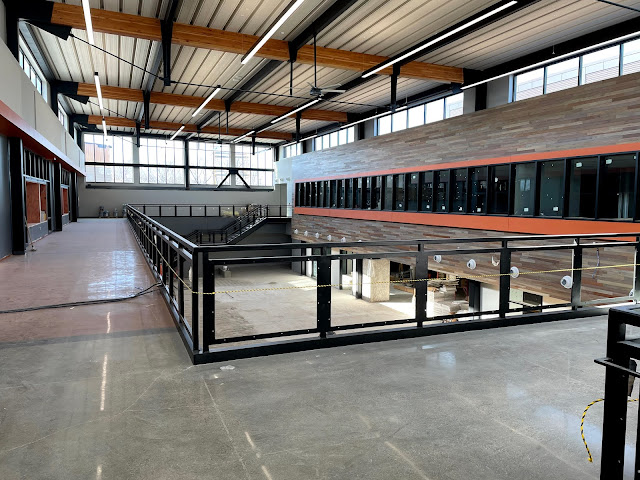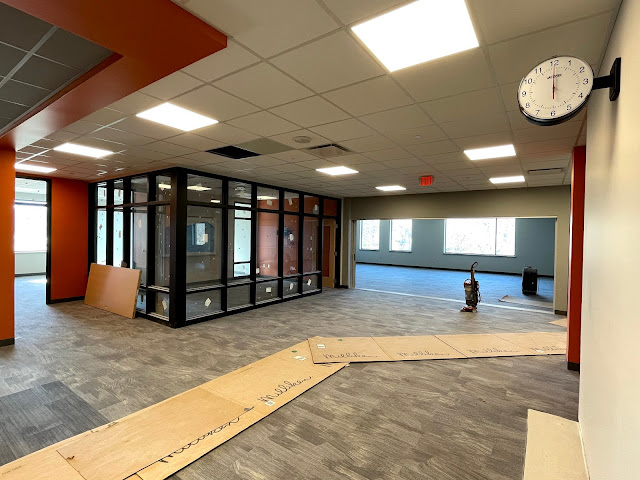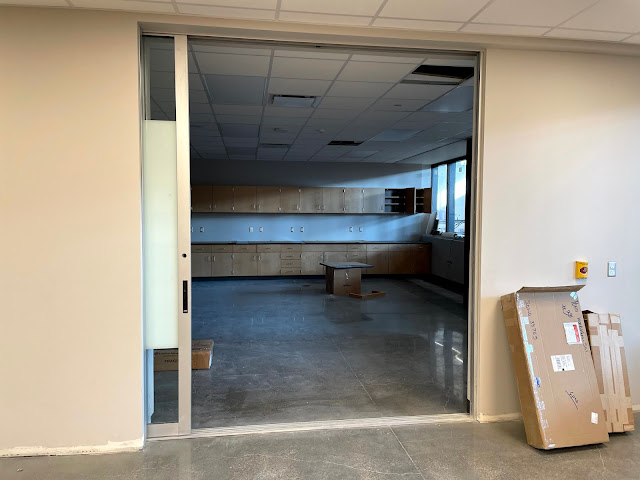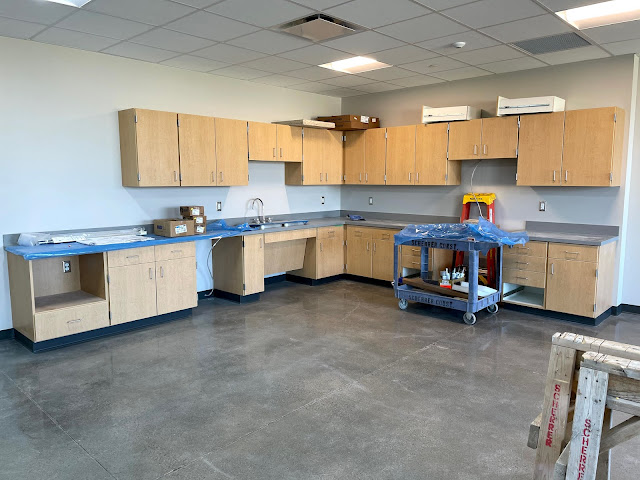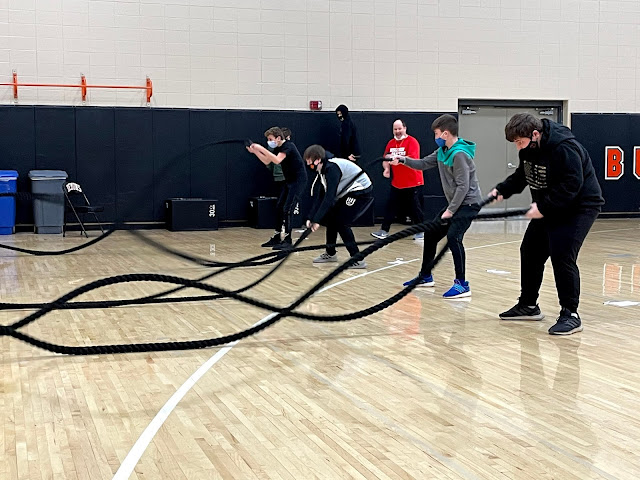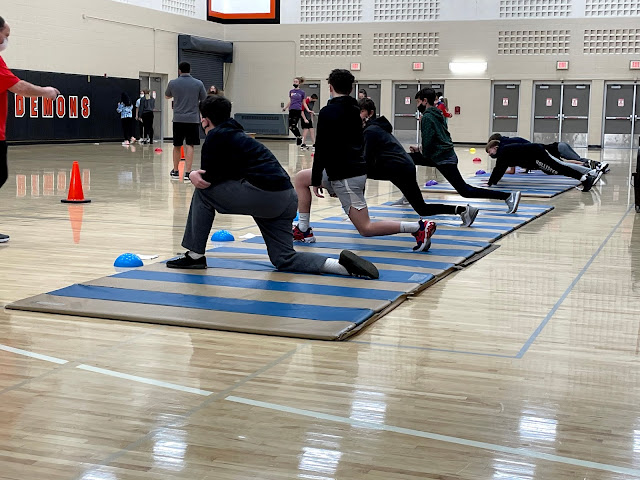- Thank you again to our BLT team for your commitment to our students and staff. Coming forward to share your concerns about a block schedule for 7th and 8th grade students were great points! As I always tell Annie... I don't want you to just agree with me. You are here to bring a different perspective, question each other's ideas, and work collaboratively as a team. You all did that!!! That is what I have always hoped for within a leadership team - a team that is not afraid to bring up concerns as the concerns need to be brought to the table to make the best decisions! True GEESE for sure :)))))) Listen to your flock - they are your team :)
- We had a HUGE group of staff wanting to participate in the new Karcher Middle School Principal interviews. The first round of interviews will be taking place this Wednesday starting mid-morning and going into the evening. We will be bringing in 9 candidates from a pool of 49 people. Each of the candidates will engage in about a 20 minute screener with Annie Phillips, Ryan Heft, Steve Plank, and myself. Then, from there we will narrow down the 9 candidates to return for the second interviews on Wednesday, April 7th. During the second interview process the candidates will rotate through a series of tasks/interviews/tour of new school. It is these interviews, on April 7, where the full team interested in assisting will be asked to participate!
- This is the group who have asked to participate:
- Melissa Miskell, Jess Maike, Carrie Heck, Susie Fleischman, Andrea Hancock, Patti Tennhagen, Kailee Smith, Stephanie Rummler, Kurt Rummler, Shannon Sonnenberg, Deanna Hawk, Rod Stoughton, Suzanne Dunbar, Steve Berezowitz, Michelle Pulera, and Kim Moss.
How Teachers Can Welcome Remote Students Returning to In-Person Learning
For many teachers, change seems to be the only consistent part of this school year. Whenever they get into a comfortable groove, new policies or student options require them to adjust their teaching style and develop new lesson plans.
The latest hurdle facing instructors is the return to in-person teaching as previously remote students head back to the classroom. Some students plan to return in January at the start of the spring semester, while others trickle in every few months.
These returning students can create challenges for teachers who want to keep everyone in their classrooms on the same page. Keep reading to learn how you can help these students both academically and in terms of social-emotional development.
Be Prepared to Help Your Students Navigate Change
Both you and your students have become experts in handling last-minute decisions by parents, administrators, and state officials this year. However, there may be a few changes that catch your students off guard as they try to re-enter the classroom.
For example, growing COVID-19 cases are causing some districts to reverse their plans for in-person learning. In one Virginia district, 6,800 students were supposed to return to in-person learning in November, but that decision was pushed back as coronavirus cases spiked.
“The current health metrics for COVID-19 cases in our community now exceed the threshold to expand our in-person learning,” Scott Brabrand, superintendent of Fairfax County schools in Virginia, said in a statement. “We made this decision as soon as new health metrics were released…We always anticipated the need to potentially adjust our return to school plans as necessary during this ongoing pandemic.”
Schools that move forward with in-person instruction also need to determine best practices for enforcing CDC guidelines to prevent the spread of the virus. In some cases, educators are taking a softer approach to make these guidelines positive habits that will be practiced in the long term.
“Discipline is the last option for COVID non-compliance,” Brad Hatch, assistant superintendent of secondary education at the Altoona School District in Pennsylvania, says. “We are hoping that everyone accepts individual responsibility when it comes to social distancing and masking.”
As students return to the classroom, teachers need to step in as public health advocates, encouraging parents and their kids to take the pandemic seriously in order to protect everyone.
“In-person learning is crucial for students to thrive,” the team at Public Health Insider for Seattle and King County writes. “Returning to in-classroom education will require all of us to keep rates of community spread as low as possible…Together all of us – caregivers, students, school staff and community partners – can be an active part of keeping everyone healthy and learning together.”
If everyone works together to keep the spread of COVID-19 low, then in-person teaching can resume for more students and schools can stay open.
Your Role as a Counselor and Adult In Your Students’ Lives
Along with stepping in as a public health guide this year, many teachers are also tapping into their training as counselors and advocates for students who are returning to in-person learning.
In a guide created for the American Academy of Child & Adolescent Psychiatry, Debra Reicher, Ph.D., clinical assistant professor at the Stony Brook University School of Medicine, encourages teachers to understand the situations students have experienced outside of the school environment.
“While some children are grieving the loss of a parent, others may be enjoying increased quality time at home,” she writes. “Some children are experiencing and suffering great financial loss and may be hungry and lacking in school supplies.”
Research has found a rise in domestic violence rates this year, she adds, and some students are lacking supervision as their parents take on extra work to pay the bills. Knowing what each of your students is going through can guide you to help them in the best ways possible.
Additionally, there is a right and a wrong way to help students cope with the rise of COVID-19 cases and their anxiety about returning to school. For example, the mental health professionals at Anxiety Canada want teachers to be encouraging but caution against using blanket reassurance statements, like “everything will be fine,” or “there is nothing to be worried about.”
While you mean well, these phrases can invalidate concerns students have, lack substance, and can actually “create doubt and uncertainty that may drive a need for further reassurance.”
Instead, be honest about the situation. Talk openly with your students to help them better understand their fears and the steps schools are taking to protect them.
Consider How Your Students Have Changed This Year
The students you teach this year are going to be different from the kids who normally enter your classroom. Their development path has changed because of the pandemic — but this can be a good thing.
“The unprecedented level of responsibility that school students of all ages have had to embrace is worth both celebrating and harnessing,” Dr. Carl Leonard and Dr. Gail Brown write at Teacher Magazine. “Building on these new levels of confidence and autonomy is another way for teachers to show they genuinely care for their students, creating a safe and supportive learning environment where students are challenged to strive for success.”
You may find that your students are more autonomous this year or work better on their own than in previous years. You can take steps to create lessons that reward this and encourage these positive traits.
In fact, the learned responsibilities of this year’s students might help you keep your classroom safer from COVID-19.
“It can be exasperating, as a child, to hear your parents remind you of something you think you already know,” Katherine Cusumano writes at The New York Times. The same can be said for students listening to teachers give instructions they are already aware of. “Instead, whether regarding hand hygiene or social distancing, ask kids what they should do and let them lead the conversation. This helps reinforce habits and allows them to take ownership of the process.”
This gives students ownership over the tasks, rather than feeling they need to unquestioningly do what they are told.
Don’t Pressure Students to Immediately Catch Up
Returning students (and their parents) are likely nervous enough about heading back to in-person learning. As an educator, you don’t want to immediately overwhelm them — especially if they are behind in areas they can’t easily catch up in.
“If a student didn’t get speech therapy for two months, it’s not like you can start the school year and just cram in two months of speech therapy in a month’s time,” Lauren Morando Rhim, Ph.D., cofounder and executive director at the National Center for Special Education in Charter Schools, says. “You might be able to offer extra hours or weekend services, but I’m guessing it’s going to be a long, slower progress.”
The team at Lexia Learning encourages educators to develop lesson plans with a focus on social-emotional learning, incorporating collaboration, communication, teamwork and self-awareness into the lessons. These will help students better understand their own mental state after nine months of living during a pandemic. The students will build lifelong skills while at the same time help them feel more comfortable in the classroom, which in turn can give them the confidence to catch up on knowledge gaps.
“There’s this idea that kids are behind, or that there’s this catching up to do,” Kathleen Osta, managing director at the National Equity Project, tells the American Psychological Association. “We would argue that rather than focus on learning loss, we need to help our young people process what they have learned and experienced during this tumultuous time—and nothing could be more important than their social and emotional wellness.”
That said, there are ways to help your formerly-remote students keep up with their peers, or at least take on a few extra tasks if they want to fill in any holes in their education.
“Break standards into smaller, manageable units,” writes special education teacher Kathryn Nieves. “Shortened time frames mean that objectives will take longer to teach, practice, and master, so segmenting lessons can help with planning and teaching.”
With this segmentation, you won’t have to use a full lesson to review the material, but rather a smaller unit or idea that your students can briefly review.
It’s Okay to Rebuild Your Lesson Plans from the Ground Up
While this year has been challenging — and it’s only the fall semester — there are some benefits to the pandemic and the upheaval in teaching. As educators are looking for ways to “make do” during this time, many teachers are using the pandemic to throw out old lesson plans that weren’t working and develop new ideas with new tools to engage students.
“Everyone has to rethink their teaching,” Jenn Wolfe, New York State’s 2021 Teacher of the Year, says. “Old lesson plans are out the window. There is much more talk about instruction, and teacher-to-teacher collaboration has become the norm in the faculty room.”
These new lessons not only engage students, but teach educators new ways of thinking about lesson planning. Innovation has become mainstream as teachers at all levels and budgets have tried different approaches this year.
“The COVID-19 pandemic has forced education innovation into the heart of almost every education system around the globe,” write Emiliana Vegas and Rebecca Winthrop, co-directors and senior fellows at the Center for Universal Education at The Brookings Institution. “The question is no longer how to scale innovations from the margin to the center of education systems but how to transform education systems so that they will source, support, and sustain those innovations.”
Essentially, how can school districts support educators so innovative learning isn’t a luxury that only teachers in well-funded schools can take advantage of? How can their engaging lesson plans and new ways of thinking reduce inequality in learning and reach students from all backgrounds?
As students head back to school for in-person learning, teachers are also looking to add more meaning to the lesson plans again, something that might have gotten lost as educators rushed to online learning last spring.
“There was a lot of, watch this video, fill in this worksheet,” says Jana Beth Francis, assistant superintendent of teaching and learning at Daviess County Public Schools. “Kids weren’t thinking about their work. So that’s the first step we’re taking in planning for the fall.”
It speaks volumes about the drive and passion that educators have when a global crisis is viewed as an opportunity to create something amazing from the ashes of a chaotic school year.
“Our teachers are just resilient,” Matthew Gutierrez, Ed.D., superintendent of the Seguin Independent School District in Texas, says. “They give 100 percent to everything and rise up to every challenge.”
There will likely be more challenges related to COVID-19 as we approach the one-year mark of the pandemic, but educators, students and parents can all work together to overcome issues and learn in the best ways possible.
- Monday, March 29 - Forward Exam Test Prep
- Please make sure our time in iTime is extremely intentional for all students to spiral review standards from the fall, review prior grade level concepts of importance, and ensure we have students engage in practice problems with the use of the iReady Standards Mastery questions.
- This is an expectation within all iTimes for all teachers who have an iTime. Please plan this out with your teams.
- The first Forward Exam Test will be on April 22 - so make plans starting this week until April 22.
- Monday, March 29 - Burlington Connected Meeting in the BHS library from 2:40-3:00 to discuss how Burlington Connected will function alongside our in-person students.
- Wednesday, March 31 - BASD Sponsored COVID Vaccination Day.
- This is a virtual day for all students K-12.
- Please make sure you send what students should work on virtually by 8:00am on the 31st.
- 7:15-7:45am - BLT Meeting to finalize Forward Exam plans.
- We have decided to use April 22 as a full day for testing. All 7-10th grade students will be attending while the 11-12th graders have a virtual learning day. All of our 7th grade testing would be completed and 8th grade we would then just need to figure out a schedule for the Science and Social Studies portions of the Forward Exam.
- 8:00-9:00 - Microaggressions conversation/survey.
- Kurt Rummler will be taking the lead with the team focusing around the impact of microaggressions. This aligns with the work we have been doing all year with the National Equity Project.
- This will take place in the BHS library.
- Wednesday, March 31 - Screener MS Principal Interviews
- Annie Phillips, Ryan Heft, Steve Plank, and myself will be starting interviews at 11:30 through 5:00pm at Karcher.
- Friday, April 2 - No School!
- HERE is the teacher schedules for the start of 5 days in-person on April 6. Please let your BLT member know if you see any errors, mistakes, or items missing!
- Monday, April 5 - Inservice Day (8:00-4:00)
- 8:00 - 11:30 is teacher work time - focus this time on the return to in-person
- 11:30-12:30 lunch on your own
- 12:30-1:30 - Building Level Time
- Focus on looking at our Microaggression Staff Survey Data to see themes, trends, and discuss next steps.
- Gain information on how we will tag items for the move to new Karcher.
- 1:30-4:00 - Time at old Karcher taping items that should go to new Karcher (the process we will be using K-12 will be explained to the team at the end of the 12:30-1:30 building level time).
- Thursday, May 20 - 8th Grade Recognition
- In the past BLT has asked to move the recognition to an evening time. This is the year to do it, especially given that so many families have most likely missed work numerous times due to COVID. Therefore, we will be holding our 8th grade recognition Thursday night starting at 7:00pm.
- It is the expectation that all 8th grade advisory teachers and staff for musical performances are in attendance.
- Those who would like to come but don't have an 8th grade advisory we will have a set section for you to sit in.
- Friday, May 21 - Last day of school!!!
- No school for 8th graders
- Early release @ 12:00 for our 7th graders.
- This would be a great day to use as a team building day, transition day (in the future), etc.
- We will not be able to take students over to the new school for the transition piece at this time.
- May 24th and May 25th
- There have been questions about May 24th and 25th when it comes to expectations and the "why".
- May 24th is an inservice day where the focus of that day will be checkout - you won't be able to check out on Friday, May 21st. The second thing we will be focusing on for the 24th is ensuring everything is ready for all of the moves that have to happen across the school district.
- Section 12.03, page 52 of the employee handbook states that personal leave days will not be granted during the first or last week of a semester, on a parent-teacher conference day, or on an inservice day.
- May 25th is a comp day for certified staff. There are always two comp days built into the calendar - one 1st semester (was the Wednesday before Thanksgiving Break) and for 2nd semester it will be May 25th. These comp days are put in place for the 8 hours of parent/teacher conference time used within the semester. So, because you are attending those times for conferences you get a day off, which, in this case is the 25th.





